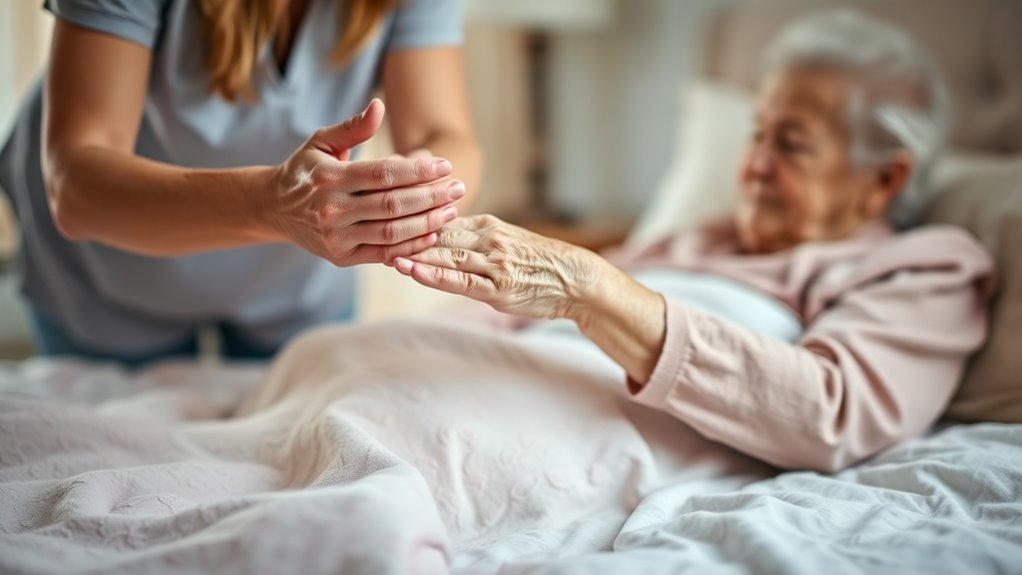Gentle range-of-motion routines help maintain joint flexibility, improve circulation, and prevent stiffness in bed-bound Alzheimer’s patients. Focus on slow, deliberate movements that promote comfort and relaxation, supporting head, neck, arms, and legs with supportive techniques. Always observe your loved one’s cues and adjust based on their responses. Creating a calm environment and using proper techniques can make these exercises safe and effective. Continue exploring to discover detailed steps for each movement and tips for success.
Key Takeaways
- Use slow, deliberate movements to maintain joint flexibility and prevent stiffness in bed-bound Alzheimer’s patients.
- Support and stabilize limbs gently, ensuring comfort and avoiding discomfort or injury during exercises.
- Incorporate calming techniques like essential oils and a quiet environment to enhance relaxation and emotional well-being.
- Regularly monitor facial expressions, breathing, and body cues to tailor routines and ensure patient comfort.
- Focus on neck and head mobility with gentle support and steady pressure, avoiding sudden movements to prevent discomfort.
Understanding the Benefits of Range‑of‑Motion Exercises
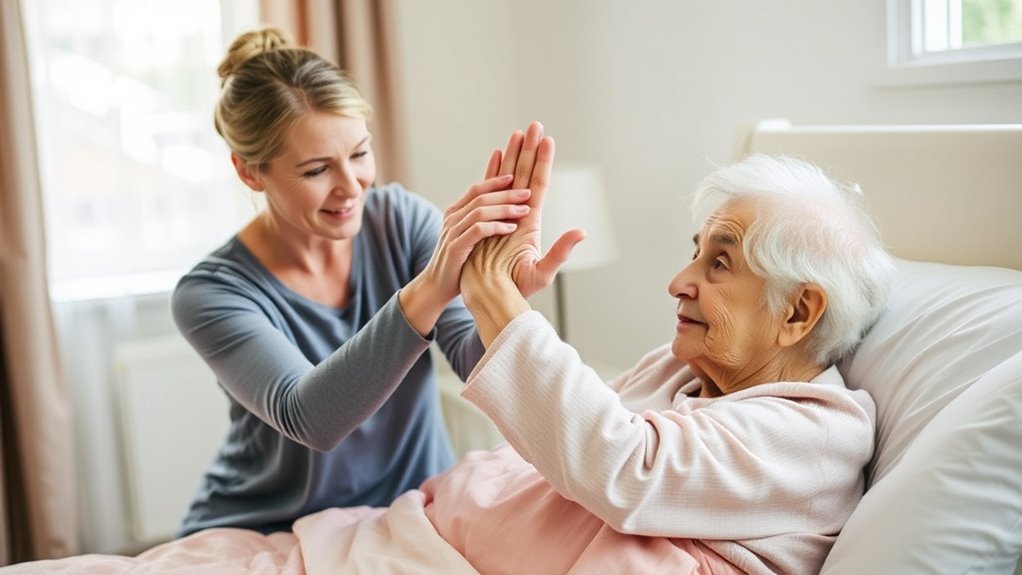
Range-of-motion exercises offer indispensable benefits for bed-bound Alzheimer’s patients by helping maintain joint flexibility and prevent stiffness. These movements keep your loved one’s joints healthy and reduce discomfort caused by immobility. These exercises also promote mindfulness by encouraging awareness of physical sensations and present-moment focus. When you regularly perform these exercises, you help improve circulation, which lowers the risk of blood clots and pressure sores. Additionally, maintaining joint mobility can support better posture and ease daily activities, even if they’re minimal. These exercises also provide a gentle way to engage your loved one physically, which can boost their overall well-being and mood. Consistent routine helps prevent the decline of muscle strength and joint function. Moreover, incorporating these exercises can be part of a diverse exercise routines that promote overall health. Ultimately, these simple movements play a vital role in preserving your loved one’s quality of life despite limited mobility.
Preparing for Safe and Comfortable Routine Sessions
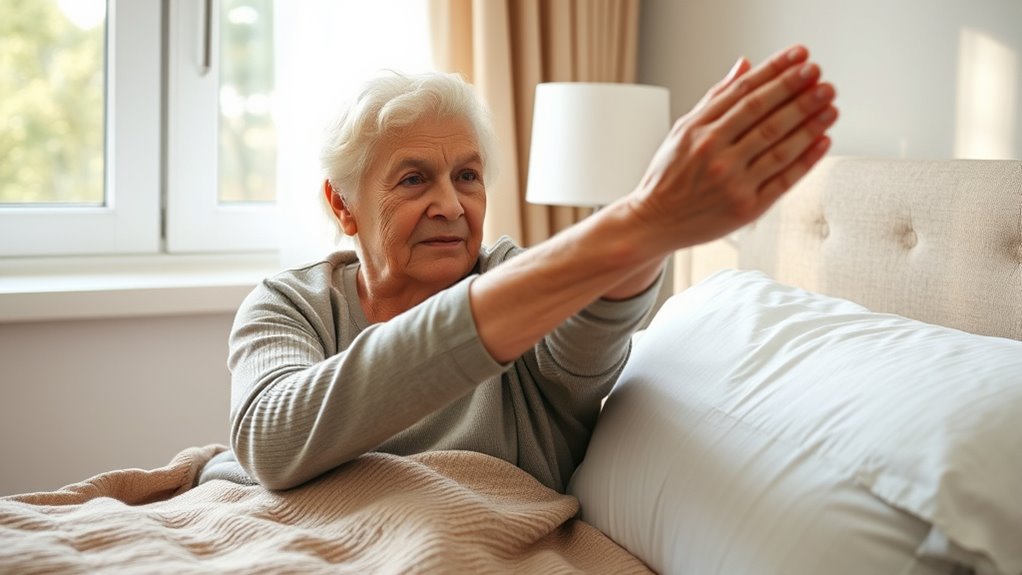
Before beginning each session, make sure your patient feels comfortable and relaxed. Gather all the supplies you’ll need, like lotion and support pillows, to keep the process smooth. Finally, check the environment for hazards to guarantee a safe, calming space.
Assess Patient Comfort
Ensuring patient comfort is a crucial step before starting any range-of-motion routine, as it helps prevent unnecessary distress and injuries. Take a moment to observe your patient’s facial expressions, body language, and breathing patterns. Check their skin for redness or discomfort, and listen for signs of pain or agitation. Adjust the environment if needed—dim the lights or reduce noise—to help them feel more at ease. Communicate softly, asking how they’re feeling or if anything hurts. Remember, their cues are essential for guiding gentle adjustments.
- Observe facial expressions and body language
- Check skin for redness or pressure points
- Adjust lighting and noise levels
- Ask about comfort and pain levels
Gather Necessary Supplies
Gathering all necessary supplies before starting a routine guarantees the session goes smoothly and safely. You want to have everything within reach to prevent interruptions and ensure comfort. Prepare items like lubricants, washcloths, and clean towels, and keep a glass of water nearby. Use the following table to visualize your setup:
| Supplies | Purpose | Location |
|---|---|---|
| Lubricant | Ease joint movement | On the bedside table |
| Washcloths | Gentle cleaning or wiping | Near the basin |
| Towels | Support and comfort | Folded nearby |
| Water | Hydration after routine | Within reach |
Having supplies organized saves time, reduces stress, and creates a calm environment for both you and your patient.
Ensure Environment Safety
Creating a safe environment is essential to prevent accidents and make the routine more comfortable for your loved one. Start by removing tripping hazards like loose rugs, clutter, or cords from the area. Confirm the bed and surrounding furniture are stable and close to prevent falls. Keep the room well-lit to improve visibility and avoid sudden shadows that might startle your loved one. Finally, check that all necessary supplies are within reach, so you don’t have to leave them unattended during the session.
- Clear pathways and secure loose rugs
- Ensure furniture is stable and positioned safely
- Maintain good lighting throughout the room
- Keep supplies nearby for easy access
Step-by-Step Guide to Gentle Shoulder and Arm Movements
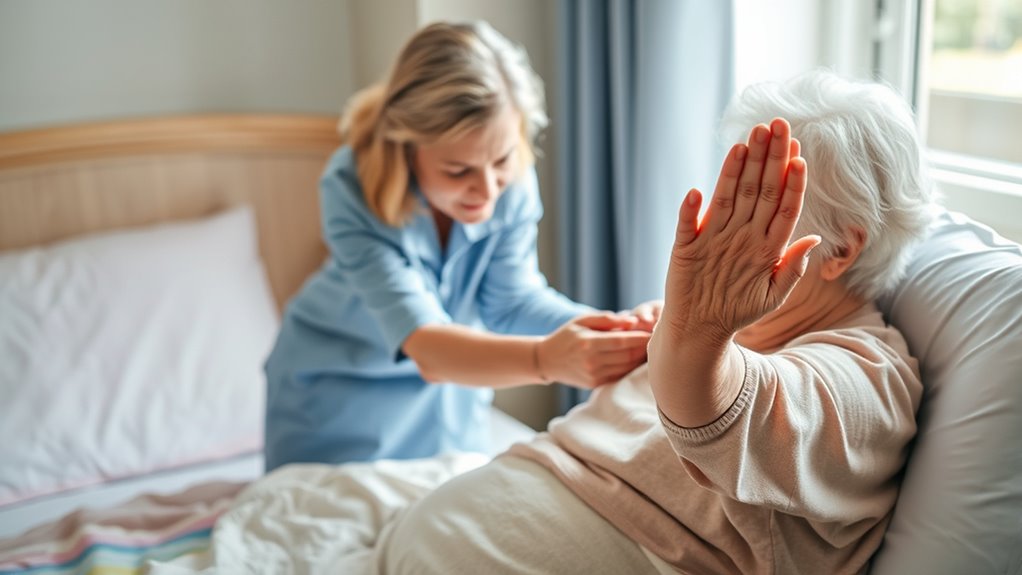
Before starting, make sure your patient is comfortable and relaxed. Gently guide their shoulders and arms through slow, controlled movements, paying attention to their cues. Focus on smooth, deliberate actions to keep the routine safe and effective. Incorporating calibration techniques can help ensure the movements are tailored to your patient’s specific needs and comfort levels. Adjusting the routine based on patient feedback can further enhance safety and effectiveness. Recognizing the importance of emotional well-being can also support a more positive and trusting routine. Additionally, selecting appropriate natural materials can contribute to a calming environment that promotes relaxation. Using portable medical equipment designed for comfort can further enhance the overall experience and effectiveness of the routine.
Preparing for Movements
To guarantee safe and effective movements, it’s important to prepare your patient gently and calmly. Begin by explaining what you’re about to do to help ease any anxiety. Confirm the room is warm and quiet to promote relaxation. Check the patient’s comfort, adjusting pillows or bedding if needed. Make sure your hands are clean and warm to prevent discomfort. Use slow, deliberate motions, maintaining eye contact to reassure them. Before moving, gently support their arm and shoulder, ensuring they feel secure. Keep movements smooth and controlled to avoid startling or hurting your patient. Remember, patience and a calming approach help make the routine safe and comfortable for both of you.
- Explain intentions clearly
- Confirm a comfortable environment
- Warm hands and gentle touch
- Support and reassure throughout
Performing Gentle Movements
Begin by supporting your patient’s arm and shoulder gently, ensuring they feel secure. Slowly move their arm upward, guiding it smoothly without forcing. Keep your movements steady and deliberate to prevent discomfort. If they resist, pause and reassure them with a calm voice. When raising the arm, stop just short of resistance or pain. Gently rotate the shoulder if appropriate, always watching for signs of discomfort. Lower the arm carefully, maintaining support throughout. Repeat this process gradually, focusing on smooth, gentle motions. Remember to communicate softly, explaining what you’re doing if your patient is alert enough to understand. These gentle movements help maintain joint flexibility and circulation, reducing stiffness and discomfort in bed-bound patients.
Techniques for Supporting Neck and Head Mobility
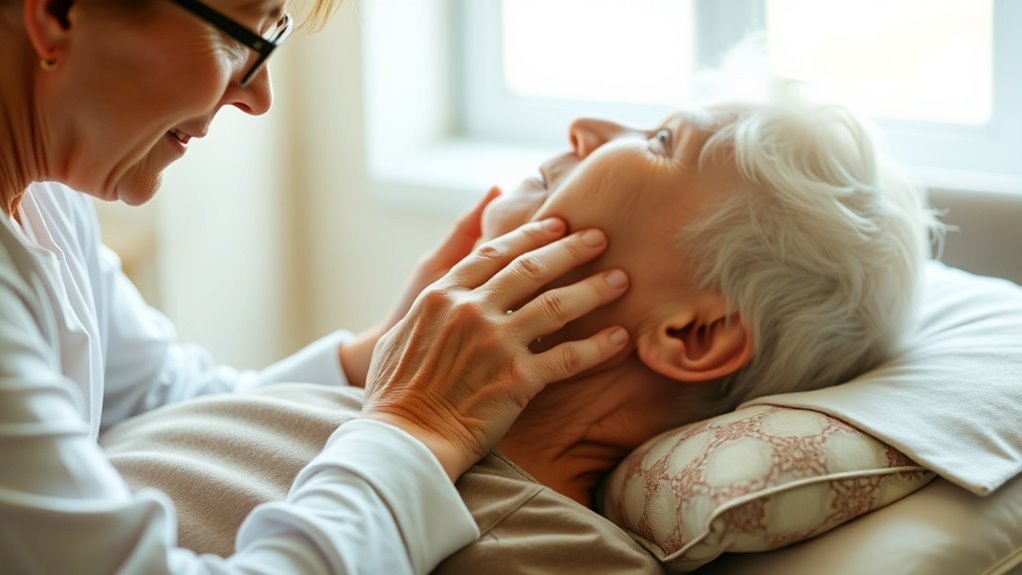
Supporting neck and head mobility in bed-bound Alzheimer’s patients requires gentle, purposeful techniques that promote comfort and prevent stiffness. Begin by supporting the head with one hand behind the neck and the other under the chin, guiding slow, smooth movements. Avoid sudden twists or jerks to prevent discomfort. Use light, steady pressure to turn the head gently side to side, maintaining alignment. Communicate throughout to ensure they’re comfortable. Focus on controlled movements to reduce resistance and anxiety. Remember, patience is key—stop if they show signs of discomfort. Regularly check for skin integrity, especially around the neck. By applying these techniques, you help maintain flexibility and reduce the risk of muscle contractures.
- Use gentle, steady support for smooth motion
- Keep movements slow and controlled
- Communicate clearly and comfortingly
- Monitor skin and comfort levels throughout
Incorporating Leg and Hip Exercises Into Daily Care
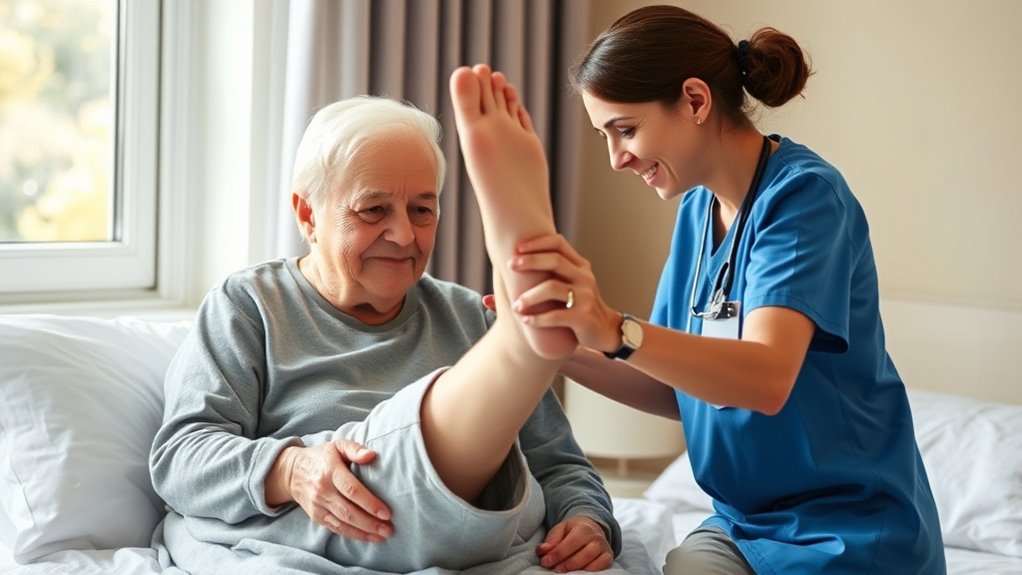
Incorporating leg and hip exercises into daily care helps maintain mobility and prevent stiffness in bed-bound Alzheimer’s patients. Gentle movements, like ankle circles, leg lifts, and hip stretches, encourage circulation and joint flexibility. Start by supporting their leg and gently moving it through a comfortable range of motion, avoiding any pain or discomfort. Focus on slow, deliberate movements to promote relaxation and muscle engagement. Repeat each exercise several times, ensuring your loved one remains comfortable throughout. Incorporating movement awareness into routines can also enhance relaxation and emotional well-being during exercise sessions. Engaging in these gentle routines can also stimulate neuromuscular pathways, promoting better coordination and sensory integration. Incorporating self-directed movement can empower patients to participate more actively in their care, even with limited mobility. Additionally, understanding the importance of proper technique can help prevent injuries and ensure exercises are both safe and effective. Integrate these routines into your daily caregiving to promote circulation, reduce stiffness, and support overall comfort. Always observe their response and adjust the exercises as needed.
Tips for Monitoring and Adjusting to Your Loved One’s Response

Monitoring your loved one’s response during exercises is essential to guarantee their safety and comfort. Keep a close eye on their reactions, noting any signs of pain, discomfort, or fatigue. If they seem distressed or unresponsive, gently pause and reassess. Adjust the routine based on their cues, such as slowing down or reducing the range of motion. Always communicate softly, checking in with them throughout. Observe their breathing, facial expressions, and body language to gauge comfort levels. Remember, every individual responds differently, so flexibility is key. Be patient and attentive, making changes as needed to ensure the exercises remain safe and beneficial. Incorporating essential oils for relaxation into the environment may also help soothe and comfort your loved one during the routine. Being aware of individual responses can guide you in customizing exercises to suit their unique needs. Paying attention to the importance of tailored routines ensures that your approach remains compassionate and effective. Your attentiveness helps create a positive, supportive experience for your loved one.
Frequently Asked Questions
How Often Should Range-Of-Motion Exercises Be Performed for Optimal Benefits?
You should perform range-of-motion exercises at least once or twice daily to guarantee optimal benefits. Consistency helps maintain joint flexibility, prevent stiffness, and improve circulation. Keep sessions gentle and within the patient’s comfort level, and watch for any signs of discomfort. Regular routines also promote muscle strength and reduce the risk of contractures, especially for bed-bound individuals. Adjust frequency based on individual needs and medical advice for the best outcomes.
Are There Signs Indicating My Loved One Is Experiencing Discomfort During Exercises?
Imagine your loved one as a delicate flower, needing gentle care. If they show signs like grimacing, fussiness, or pulling away during exercises, it’s like a storm brewing—indicating discomfort. Watch for changes in facial expressions, body tension, or resistance. These signals warn you to slow down, adjust, or pause, ensuring their comfort. Your attentive presence helps nurture their well-being, transforming routine into a gentle, caring ritual.
Can These Routines Be Adapted for Patients With Additional Health Conditions?
You can definitely adapt these routines for patients with other health conditions. Start by consulting their healthcare team to guarantee safety. Modify movements to suit their specific needs and limitations, avoiding anything that causes discomfort or pain. Use gentle, slow motions, and monitor their responses closely. Personalizing exercises ensures they remain beneficial without risking injury, making routines safer and more effective for individuals with multiple health concerns.
What Should I Do if My Loved One Resists or Becomes Agitated During Exercises?
Like trying to steer a boat through choppy waters, managing resistance during exercises can be challenging. If your loved one resists or gets agitated, stay calm and patient. Gently pause, speak softly, and offer reassurance. Sometimes, a brief distraction or a change in activity helps. Respect their cues, and never force movements. Your calm approach can create a safe space, easing their discomfort and encouraging cooperation.
How Can I Make the Routines More Engaging or Comforting for My Loved One?
To make routines more engaging or comforting, focus on creating a calm, soothing environment. Use gentle, slow movements and maintain a relaxed tone to reassure your loved one. Incorporate familiar music or soft words they enjoy to distract and comfort them. Keep sessions short and positive, praising their efforts. Your gentle presence and patience help turn exercises into a comforting, reassuring experience that encourages cooperation and eases agitation.
Conclusion
By incorporating gentle range-of-motion routines, you create a caring rhythm that keeps your loved one’s body active and engaged. These simple exercises act as a gentle tide, helping to maintain mobility and comfort. Remember to watch for their responses and adjust as needed, turning daily care into a soothing dance of compassion. With patience and consistency, you help preserve their independence and dignity—one gentle movement at a time.
